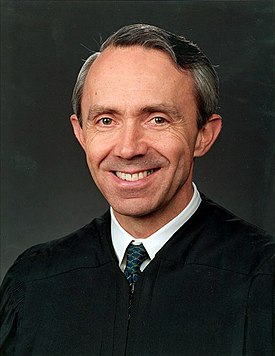United States v. White Mountain Apache Tribe
United States v. White Mountain Apache Tribe, 537 U.S. 465 (2003), was a case in which the Supreme Court of the United States held in a 5–4 decision that when the federal government used land or property held in trust for an Indian tribe, it had the duty to maintain that land or property and was liable for any damages for a breach of that duty.
The case involved Fort Apache, a collection of buildings on the reservation which were transferred to the tribe by the United States Congress in 1960.
Although the tribe owned the Fort Apache buildings, they were held in trust and used exclusively by the federal government for an Indian school.
The government then appealed to the U.S. Supreme Court, arguing that the tribe could not make a claim without Congressional authorization.
The buildings are managed by the Fort Apache Heritage Foundation and the case, along with several others define the Indian Trust Doctrine.
The case has been widely discussed in legal literature and books, primarily in the area of Indian trusts.
In 1869 Major John Green led a force to the White River area and recommended that an outpost be established there.
[1] In 1870 Fort Apache was established by the United States Army in Arizona and remained an active military installation until 1922, when it was transferred to the Department of the Interior (DOI).
[7] With the reduction in the number of students, the BIA budget for Fort Apache also dropped, causing deferred maintenance and the demolition of several buildings.
[11] By 1993, the tribe had adopted a master plan to try to preserve the buildings and commissioned a study to determine what the cost would be to restore the property.
[14] In 1999, the tribe filed suit in the United States Court of Federal Claims, seeking $14,000,000 in damages for breach of trust by DOI.
[15] The tribe argued that the United States had exclusive control over the buildings and allowed them to fall into disrepair, a violation of the trust relationship established by the 1960 statute.
[32] Further, he argued, the exclusive control does not create liability; only the explicit language of statutes and regulations could allow monetary damages.
[34] Robert C. Brauchli, an attorney from Arizona, argued the case for the White Mountain Apache Tribe.
[43] In Mitchell II, the United States also held the land in trust, but actively controlled the property through comprehensive timber management regulations.
Ginsburg expanded on the differences between the lack of liability under Mitchell I and the imposition of damages to compensate "for the harm caused by maladministration of the property.
Thomas stated that the test has always been if the statute in question could be "fairly interpreted" to allow monetary damages.
[56] He stated that the majority had devised a new test: whether liability could be allowed on a "fair inference" of congressional authorization.
[58] He further said that without a clear and unambiguous intent by Congress to make the United States liable, there could be no finding of monetary damages.
Some of these were critical of the majority approach, stating that it went beyond the plain meaning of the text to open up the federal government to liability where none existed.

